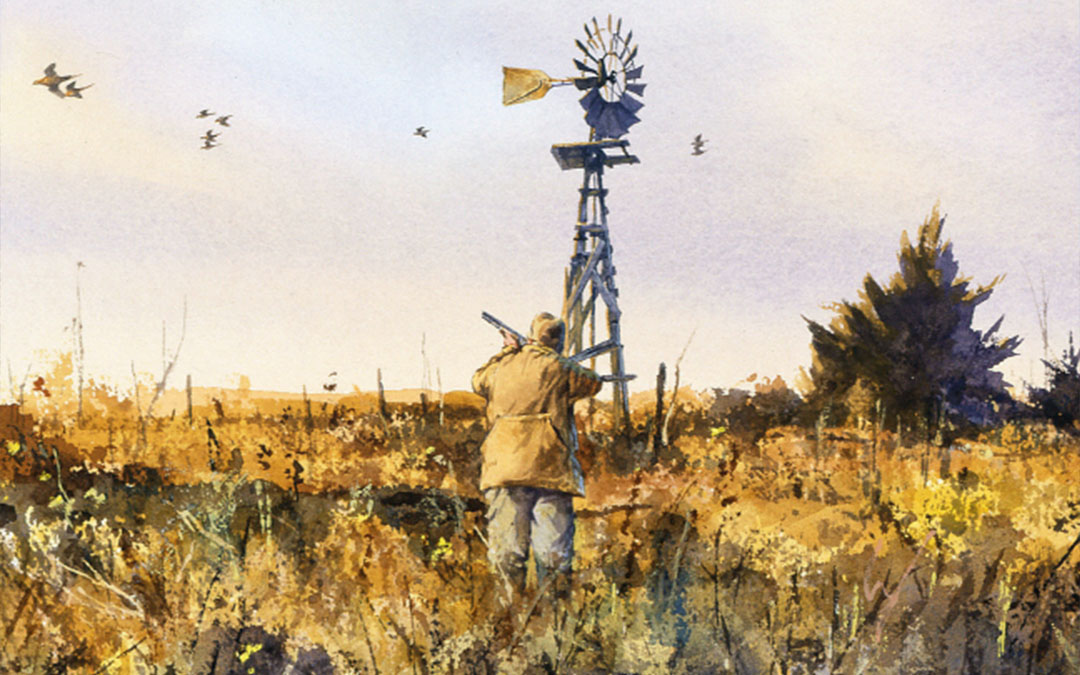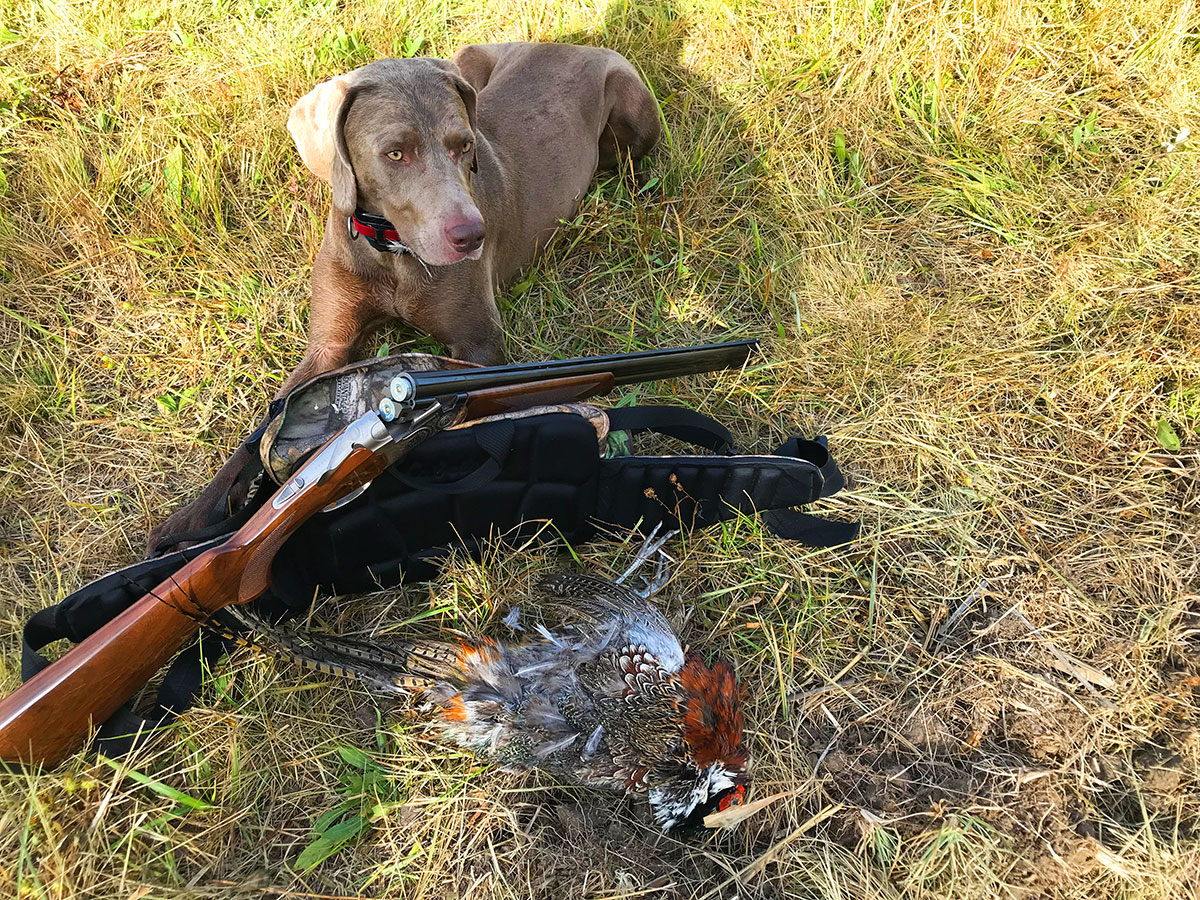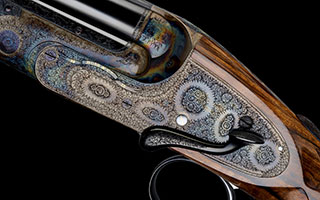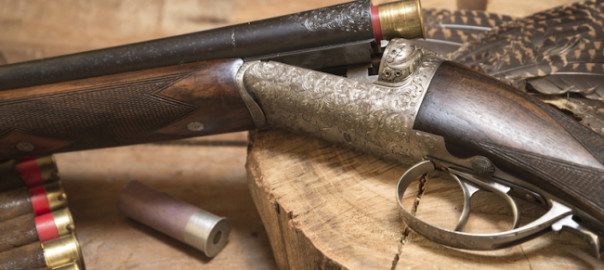I swore to lock up the 28-gauge Perazzi, safe and sound, and return it when asked. But I simply could not, would not, make this trip without her.
I have always been lucky with dogs and shotguns. Or maybe just unlucky with everything else. In any event, one evening the doorbell rang and my neighbor, Sonny, stood there with a gun case. A really nice gun case.
“Hide it for me,” he said. “Quick.”
My wife called from the kitchen. “Who is it?”
“Nobody.” This seemed rude. “It’s Sonny.”
“Tell him I have zucchini for Brenda.”
We hustled downstairs to the basement den where I keep my guns, my dog equipment, my fly-fishing equipment, coolers, hip waders, shells and camping gear all mixed together. I also have a mini fridge filled with beers and sodas. Not exactly the Eagle’s Nest, but it works.
We cracked a cold one and I laid the case on the pool table. Hard-sided and leather-trimmed, it had a heavy silver lock and fancy tooling reading “Perazzi.”
Sonny explained that the gun belonged to his boss who needed a safe place to hide it. I understood, having hidden guns myself. When you own 17 shotguns, you don’t just waltz through the door with number 18.
“You know anything about shotguns?” Sonny asked.
“A little,” I replied.
“The boss’ whole family shoots,” he said. “All the men. And women. They’re coming for a reunion and they always want to see his guns. He said they can’t see this one.”
We opened the case.
For a moment we just stared. Then stared some more. It was an exquisite over-and-under shotgun with a straight stock of beautiful burled walnut. Elaborate scrollwork, the kind you pay big bucks for, graced the steel. And not just any scrollwork. A totally naked woman reclined across the receiver.
You heard right. Naked.
Sonny looked at me. “Can you keep it?”
“I can keep it.”
Over the next few days, I had the gun in and out of the case more often than I care to admit. If my wife came down the stairs, I put it away…fast.
Perazzi shotguns are made by masters at a modern facility in Italy. For the most part, the company specializes in over-and-unders, as though this configuration makes all others obsolete. They might be right.
The gun was a lovely 28 gauge, with barrels and a receiver that snapped together with a subtle click. I did a little research and estimated the gun to be 30 years old. The nude had been engraved by Angelo Galeazzi, a well-known master. In typical European style, the old gent left little to the imagination. The nude reclined across the receiver, surrounded by flowers, grouse and geese.
 I named her Camille for some reason. She never failed to surprise and intrigue me. I wanted her, desperately. The gun, I mean.
I named her Camille for some reason. She never failed to surprise and intrigue me. I wanted her, desperately. The gun, I mean.
Dove season started in a week. I hate dove season. That’s not true. It’s just that you have to drive 200 miles to the South Dakota prairie. Spend the night with mice in a drafty old house. Stand on a field edge the next day, slapping mosquitos and getting a sunburn. All while staring at an empty sky.
Two years ago, it had been different. Ten of us posted up along a fence line under stunted box elders. We could see flocks of doves trading off in a big grove of trees to the north. Some kids with guns walked by heading for the woods. They started shooting. The sky came alive, with thousands of birds peeling off the trees and rocketing across our hay field.
We opened fire like gunners on the Maginot Line. You can spend a whole season shooting doves and never get the same shot twice. They flare skyward like a duck. They swoop low, and you think they’re going to land. At the last moment they dart up, right past your ear. You get skeet shots, high tower and low. There are going-away shots, like trap. Passing birds turn around and give you another crack, for no good reason.
With so many chances, it should be easy—and we had chances. Looking through the sulphur haze, I saw empties flying from pumps, over-and-unders and automatics.
After 10 minutes we had three birds down. You can see why there are so many doves. No one can hit them.
The gang ran into town and cleared the hardware store out of game loads. With so many opportunities, our shooting improved. By Sunday, we managed to collect quite a few birds. I shot about 20, if only by accident, which is mostly how I hit anything, anyway.
We all agreed we would never miss another South Dakota opener. The next year found us back on the prairie. I think we returned with seven doves.
The locals said the birds hadn’t flocked up. “Come back next weekend,” they said. “They’ll be thick as fleas on a coon hound. Or the end of September. You just never know. That’s dove hunting,” they said.
Actually that’s life in general, I thought.
Ever-so-gently I removed Camille from her case, then ran a soft cloth over her. After cleaning the barrels, I removed excess oil from the receiver, which can affect the wood. There is something about a 28 gauge. The difference in payload between the 28 and 20 is minimal, perhaps a fifth less powder and pellets. The difference is feel. The barrels are lighter, the swing quicker. Perazzi places a generous forend on their guns, which I like. I think a shotgunner aims with his hand as well as his eyes, and some English side-by-sides have stocks that are a bit too dainty for me.
My friend Bob called. I put the phone on speaker. “Are you coming to South Dakota with us?” he asked. “Word is the doves are flocking.”
“I don’t know,” I said, shouldering the Perazzi. “I remember last time.”
“This will be different,” Bob said.
An imaginary dove flew at me, then darted to the right. It never stood a chance. Sonny would be back any day for the gun. I had accepted it as a sacred act. I was to lock it up safe and sound, and return it when asked. We were talking about his boss, after all. His career. But I simply could not, would not, make this trip without her.
“When do we leave?”
Bradford, South Dakota sits on the high prairie 42 miles from the interstate. It’s a town of gravel roads except for Main Street, which is anchored by an old, high-steepled church. You can see the steeple from a great distance. Down the block is a little grocery store with a freezer and shelves holding Aunt Jemima pancake mix and Dinty Moore stew. Another shelf is stocked with cotton gloves and blue jeans. The waist sizes start at 42.
Bradford has a gas station/hardware store, and Old Man Hankinson still works there, but the pumps haven’t worked since 1976. The sign still reads .59 cents a gallon. In an emergency, the old guy can sell you a few gallons out of the farm tank in back.
There’s a friendly little saloon in Bradford. They serve a quart mug with a drink called the Stump Lifter, which is made from 7-Up, vodka, rum, whiskey and applejack brandy. The bartender mixes it with a wrench. Only one is allowed per customer.
Bob’s grandmother passed away 17 years ago and when Bob found the house was selling for $6,000, he bought it himself. As a kid, Bob shot his first pheasant a hundred yards back of the house. The taxes are $14 a year.
We sat on the porch drinking iced tea with raspberries, waiting for the others to show up. After life in the city, the silence of the prairie countryside can be intimidating. You can hear a car from miles away.
Sipping, I turned and looked east.
“That would be Trevor,” Bob said.
The next day we drove to our hayfield. On the way, we passed a public hunting area with a long row of poplars. I could see doves.
“What about over there?” I asked.
“That’s not where we’re hunting,” Bob said.
 We arrived at the field and found it newly cut and full of seeds. A good sign. Six of us posted up along a fencerow. I carefully removed the Perazzi from her case and clicked her together. The gun had a silky feel in my hands. The balance point was precisely at the hinge pin, just above Camille’s lovely…let’s just say it was at the hinge.
We arrived at the field and found it newly cut and full of seeds. A good sign. Six of us posted up along a fencerow. I carefully removed the Perazzi from her case and clicked her together. The gun had a silky feel in my hands. The balance point was precisely at the hinge pin, just above Camille’s lovely…let’s just say it was at the hinge.
We heard shots and doves began flying across the field. First three or four, then dozens. Our crew opened fire, but with a year of rust to shake off, they were mostly missing—as usual.
I dropped my very first dove, a tricky passing shot, at my feet. Bob looked at me. I shot nine more in a row. Two of them going away—my worst shot. I’m not kidding. There are people who won’t shoot trap with me.
“Let me see that gun,” Trevor insisted.
Oh, no you don’t. No one was touching this gun.
The firing slackened. I was happy. I’d hit everything I shot at. We collected the birds and headed back.
“Stop the truck,” I said as we passed a state-owned wildlife management area. I saw a dove fly out of some corn and into the trees. We stepped from the Suburban and watched. A couple more flew up and landed on powerlines.
We pulled the guns and spread out on the gravel road. With the first shots, birds poured out of the field, heading for the trees. A hot afternoon wind blew into our faces and doves used it as only doves can, zipping and dodging on tightened wings.
The barrels on the Perazzi shot modified and improved. Anything more than 30 yards I let go by. It was dream shooting, where you don’t remember aiming. You only recall the gun coming cleanly to your shoulder and the 28’s little baby kick as a dove falls in a puff of soft feathers.
Right in the middle of shooting my cell phone buzzed. You can always count on something like that happening.
It was Sonny and he had one question: How soon could I be at his house with the Perazzi? His boss needed it right away.
I was too flustered to lie properly. I should have said: “I’m in the Bahamas. Or sequestered in a jury trial.” Instead, I told him I could get it to him in a few hours.
“Why not now?”
“I forgot the combination to my safe.”
“But how could you forget…is that shooting I hear?”
“It’ll come to me. I have to go.”
I got home by ten that evening. After cleaning the Perazzi’s barrels, I buffed the stock to a high polish. Then, I took a moment to say goodbye to Camille. Properly and like a gentleman. Then I cased the gun and walked to Sonny’s.
He stood waiting. Light bathed the doorstep.
“Take good care of her,” I said, handing over the gun.
“Are you okay?” he asked.
Turning away, I said, “I’m fine. I just got a bit of oil, a tiny bit, in my eye.”




